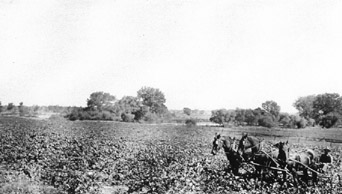|
Lower Yellowstone Valley, 1929-1930 "I first got information about the Lower Yellowstone Project through an advertisement in Western Farm Life. I wrote to F. L. Cooper, field man of the Lower Yellowstone Development Association who sent me literature. This was in 1927. Early in 1928 my brother and I drove from Longmont, Colorado, to Sidney, Montana, where we got in touch with the Secretary of the Association. He took us over the entire project. We decided to work out for a year in the vicinity the first year in order to make a closer study of local conditions. We worked for farmers near Sidney in 1928 and during the slack period made another trip to other projects. After making a comparison we then decided that the Lower Yellowstone seemed to be the best for us. We had about $4000 cash with which to start. We bought a 160-acre farm, partly improved and somewhat run down by poor farming. We took possession on March 1, 1929. During the first month we were very busy hauling fertilizer and trying to straighten things out. We had made arrangements to have 60 acres fall plowed and this ground was therefore ready early. We planted 52 acres of sugar beets; 15 acres of wheat and alfalfa seeded with the wheat; and 14 acres of wheat additional; 15 acres oats, barley and other feed; 20 acres of millet and oats for hay; 15 acres of corn. We also planted an acre of potatoes. The wheat has been threshed and averaged 40 bu. per acre. We threshed between five and six hundred bushels of oats from less than 15 acres as we cut some for hay. As this is written the beet harvest is about two weeks off. The beets are expected to make at least 12 tons per acre on an average. The corn turned out very well. We cut it with a binder and shocked it. It looked like 50 bu. per acre but we expect to use it, shredded, for feed for cattle. We are just starting and now have only three cows which give an income of about $10 a week besides milk for four or five hogs. Both my brother and I think the climate here is the best there is anywhere. Improved irrigated land can be bought at $40 an acre and upward. Unimproved land at $30 an acre or more depending on the quality and location. There are splendid opportunities here for men who are willing to work. The gross return from this year's crop amounts to $7570.50, but we expect to increase that by feeding livestock. We are very well pleased with our farm and with our treatment by the people of the valley. |
 Joseph Steinbeisser harvesting beets on
theSteinbeisser farm.
Joseph Steinbeisser harvesting beets on
theSteinbeisser farm.